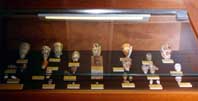MENFI
CULTURAL INSTITUTE "Federico
II"
PIAZZA Vittorio Emanuele
TEL. 092575235
VISITING HOURS:
Wed - Thu - Fri:10 am - 1 pm;
Tue - Thu - Sat - Sun: 4,00 pm -9,00 pm
FREE ADMISSION
|
 |
|
ROOMS |
ARCHAELOGYCAL SECTION
1) L. Morricone
2) T. Fazello
3) A. Bucolo - Amico
|
MALACOLOGYCAL SECTION
1) R. Tucker Abbot
2) Marchese di Monterosato
3) Claudio Ebreo
|
Inaugurated on 28 June 1997, the
museum, at the first floor of the Institute, has two sections,one
dedicated to the archeology and the other dedicated to the malacology,
the last one titled to Vanna Rotolo. In the first room of the
archeological section, L. Morricone, we can admire sea fossils
aged between 1.760.000 and 800.000 years ago, coming from Ciavolara,
Cava del Serpente. Show-cases contain interesting splintery stones
from inferior Paleolithic (Pebble Culture), points, burin and
scraper from superior Paleolithic and big fragments of elephant-tusk,
some 50 centimeters long and with a diameter of about 10 centimeters.
In the second room, T. Fazello, there are some very beautiful
intact amphoras coming from Caparrina and Porto Palo sea depth
and from excavations done near Montagnole in Belice, dated to
bronze age. The section dedicated to the archeology closes with
the room A. Bucolo - Amico, where coins are exposed. The coins
are from the Sicilian - Punic serie, and are aged from 380 to
253 B.C. and coins from Syracuse mint from 342 to 339 B.C. Looking
at the malacologycal section one feels a sense of marvelous, kindled
from the beauty of the shells. The collection is divided in three
rooms where there are explicative panels which explain and illustrate
the importance that shell has had in economy, in art, in history,
in architecture, in industry and in religion. There are also important
notes about their biology. The malacologycal collection, the only
one existing in Agrigento and its province, has been given free
by Mrs. Vanna Rotolo, who took about 20 years to put together
all these beautiful sea pieces. The most of the Mediterranean
shells come from Porto Palo depth, other specimens come from all
over the world. Some are very rare, as Conus Bengalensis, (exposed
in the room "Claudio Ebreo"), whose there are only 500
coming from Bengal Gulf.
musei e antiquaria
homepage
